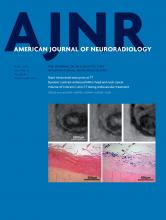Abstract
BACKGROUND AND PURPOSE: Paraclinoid aneurysms have been increasingly treated endovascularly. The natural history of these aneurysms has gradually been elucidated. The purpose of this study was to assess the safety and efficacy of endovascular treatment for these aneurysms.
MATERIALS AND METHODS: We performed a retrospective review of 377 patients with 400 paraclinoid aneurysms treated between January 2006 and December 2012. Their clinical records, endovascular reports, and radiologic and clinical outcomes were analyzed. Because aneurysms ≥7 mm are at higher risk of rupture, we classified aneurysms as small (<7 mm) or large (≥7 mm).
RESULTS: Overall, 115 of the 400 aneurysms (28.8%) were large (≥7 mm). Thromboembolic complications were found significantly more often with large aneurysms than with small ones (7.4% vs 1.0%, P = .001). Hemorrhagic complications were found only with small aneurysms (0.7%). The 6-month morbidity rates were similar for small (1.0%) and large (0.8%) aneurysms. Immediate angiographic outcomes were similar (P = .37), whereas recurrences and retreatment occurred more frequently with large aneurysms (P = .001 and P = .007, respectively). Multivariate analysis showed that aneurysm size was the only independent predictor for recurrence (P = .005). Most recurrences (81%) were detected by scheduled angiography at 6 months.
CONCLUSIONS: Aneurysm size influenced the type of complication (thromboembolic or hemorrhagic) and the recurrence rate. Given the approximately 1% annual rupture rate for aneurysms ≥7 mm, analysis of our data supports the rationale of using prophylactic endovascular treatment for unruptured paraclinoid aneurysms ≥7 mm.
ABBREVIATION:
- UCAS
- Unruptured Cerebral Aneurysm Study
- © 2016 by American Journal of Neuroradiology
Indicates open access to non-subscribers at www.ajnr.org












